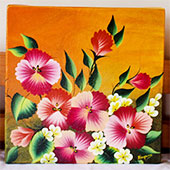Design Resource
One Stroke Painting - Bengaluru
Painting Technique
by
Prof. Bibhudutta Baraland Kiran Raj
Artist chooses brush number eight for painting nature art on the canvas, which is being framed. She used berry wine colour (purple) as a primary colour and titanium white colour as the secondary colour and added some floating medium drops. The primary colour is applied to the first half of the brush, and for another half, the secondary colour is being used. The next process is to blend these colours equally together. The brush is blended until it is completely loaded. After blending the colours, the artisan started painting rosebud on a canvas cloth. The first layer of the bud should get dry. Once it is dried, a yellow colour is being added with the white colour for the next layer of the bud.
To give depth to the bud detailing is done with the same style but different angles by painting in one stroke technique. The third layer of paint completes the bud. Then the artist paints petals to give the feel of a flower.
To paint the leaf design artist used brush number seven but chooses a different colour. The primary colour is thick, darker in the green shade, and the secondary colour used is yellow. The same technique is followed for leaf painting. The artist paints the leaves as many as required to keep the painting colourful. The technique of painting the leaf is to press hard at the beginning of the paint and go smooth as it ends. To paint a big size leaf, the artist chooses eight number brush and uses the green forest colour, which is another shade of green and yellow colour. These leaves enhance the beauty of buds. A small liner brush is used to give an outline to the buds, flowers, and leaves. A small line of the stem is drawn to connect these flower elements to enhance the painting. After this process, painting is completed and gives us a natural feel of a plant on the canvas cloth that is irresistible.
Flowchart


















